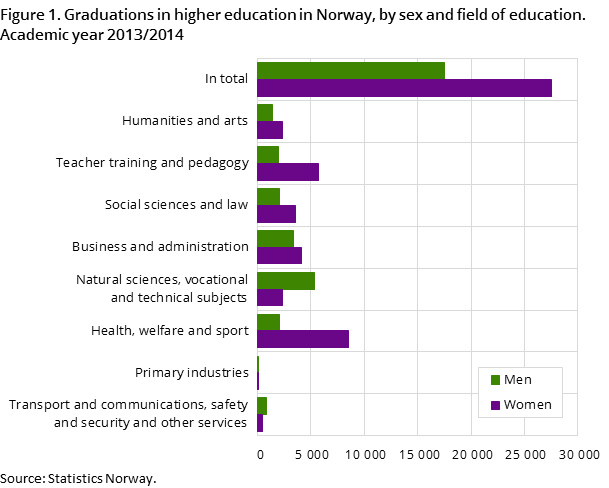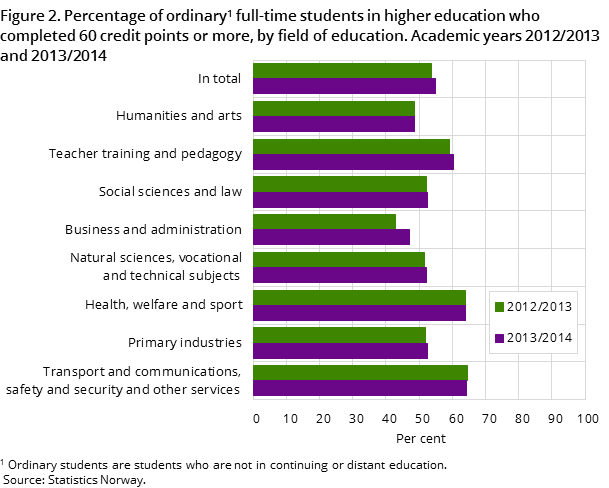Content
Published:
This is an archived release.
More higher education graduates
The number of higher education graduations increased by 3 000 in 2013/14 compared with the year before, from 42 000 to 45 000. Of this, women accounted for 27 500, or 61 per cent. This has been almost unchanged for the last ten years.
| Share | |||
|---|---|---|---|
| 2013-2014 | 2012-2013 | 2009-2010 | |
| 1Ordinary students are those registered per 1 October yyyy and are not in continuing education. | |||
| Graduations | |||
| Total | 100.0 | 100.0 | 100.0 |
| Universities | 43.2 | 43.0 | 42.3 |
| Specialised university institutions | 11.1 | 9.7 | 12.1 |
| State university colleges | 37.3 | 38.5 | 38.5 |
| Military university colleges | 0.5 | 0.6 | 0.4 |
| Other university colleges | 8.0 | 8.2 | 6.7 |
| Males | 38.9 | 39.0 | 39.1 |
| Females | 61.1 | 61.0 | 60.9 |
| Immigrants | 10.4 | 10.5 | 8.3 |
| Norwegian-born to immigrant parents | 1.9 | 1.6 | 1.1 |
| Other population | 87.7 | 88.0 | 90.6 |
| Credit points production of ordinary full-time tertiary1 | |||
| Total | 100.0 | 100.0 | 100.0 |
| Students with completed 0 credit points | 8.4 | 7.2 | 9.8 |
| Students with completed 1-29 credit points | 7.9 | 8.7 | 9.5 |
| Students with completed 30-59 credit points | 28.8 | 30.4 | 27.9 |
| Students with completed 60 credit points and more | 54.9 | 53.7 | 52.7 |


From approximately 30 400 graduations at undergraduate level in higher education, women accounted for 63 per cent. At graduate level, women made up 58 per cent.
More women than men will soon graduate at doctorate level
At doctorate level, more than 49 per cent of the graduations were by women. For years, more women than men have graduated at undergraduate level. Ten years ago, more women than men also graduated at graduate level. More men than women graduated at doctorate level in the academic year 2013/14, but updated figures from the Nordic Institute for Studies in Innovation, Research and Education (NIFU) show that more women than men graduated at doctorate level in the calendar year 2014.
The report European Higher Education Area in 2015 shows that in 15 out of 30 countries, the proportion of women at doctorate level was 50 per cent or more in the academic year 2011/12.
Half of male immigrants graduated in natural sciences, vocational and technical subjects
Most men completed a higher education degree in natural sciences, vocational and technical subjects in 2013/14. Almost half of male immigrants – or 44 per cent – completed a degree in this field; a decline of two percentage points from the year before. Among Norwegian-born men with immigrant parents who graduated from higher education, 34 per cent graduated in this field. Another 29 per cent graduated in the field business and administration. The same two fields were also the most popular among men in the rest of the population.
Most women graduated in health, welfare and sport (31 per cent). Among immigrant women, 27 per cent graduated in this field. Among Norwegian-born women with immigrant parents, as many as 40 per cent of all graduations were in this field.
It is important to note that the proportions of immigrants and Norwegian-born with immigrant parents completing a higher education degree in 2013/14 by field of education are sensitive to even small changes, as the cohorts are small.
More than half of full-time students attained 60 credit points
Sixty credit points normally corresponds to one year of full-time study. More than half – or 55 per cent – of the full-time students attained 60 credit points in the study year 2013/14. This was a small increase from the year before.
About 29 per cent – or three out of ten – of the full-time students attained between 30 and 59 credit points, 8 per cent between 1 and 29 credit points, and 8 per cent did not get any credit points.
Contact
-
Beate Bartsch
E-mail: beate.bartsch@ssb.no
tel.: (+47) 40 81 14 96
-
Nawid Fazli
E-mail: nawid.fazli@ssb.no
tel.: (+47) 97 09 77 18
-
Geir Nygård
E-mail: geir.nygard@ssb.no
tel.: (+47) 48 15 13 44
